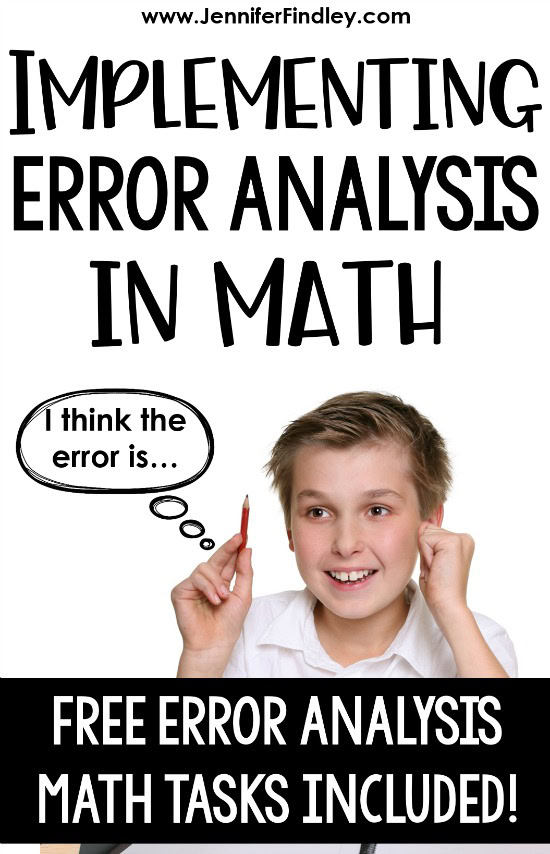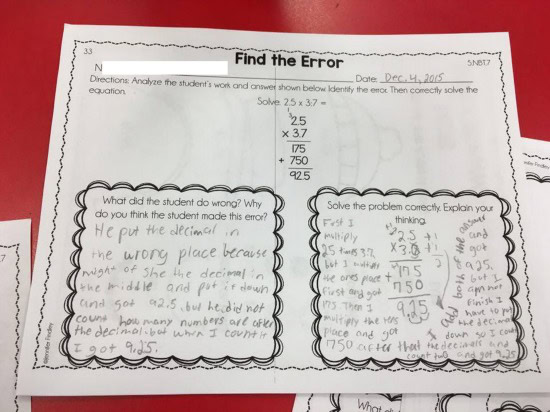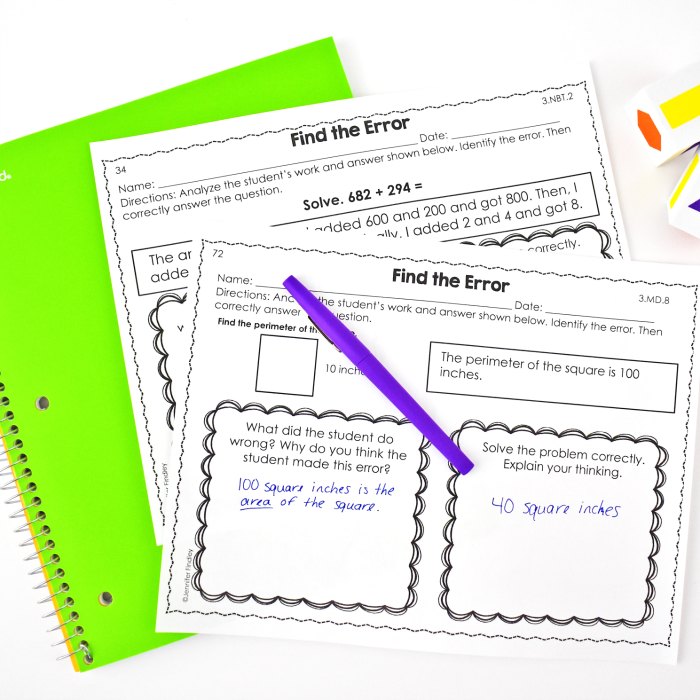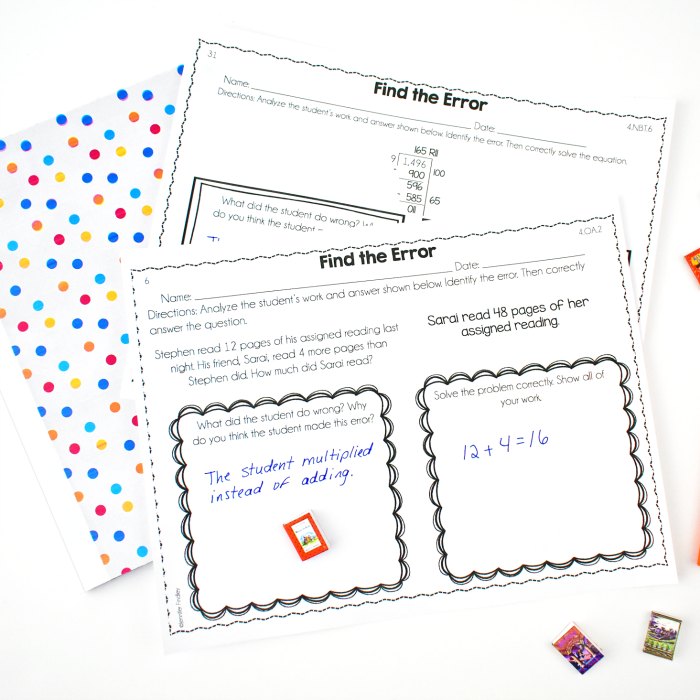One of my favorite activities to use during math instruction involves math error analysis. I love having my students dig deeper into a concept or skill by analyzing, identifying, and explaining errors in example work. In this post, I will discuss a few of my favorite benefits to using math error analysis tasks and then some ideas for how to easily implement these types of tasks in your classroom, including free error analysis tasks!
 Math Error Analysis: Why is It Beneficial?
Math Error Analysis: Why is It Beneficial?
Let’s begin with the why it is a good idea to have students analyze math errors.
- It promotes higher level thinking. According to Robert Marzano, error analysis is at the top of the higher level thinking skills. It requires students to create, analyze, and even prove their claim.
- It aids in conceptual understanding. The tricky part of having students do traditional algorithms is they sometimes lose the conceptual reasoning behind the steps. When students can find errors in a process and explain it (that part is key), they are really showing a conceptual understanding of the skill or concept.
- It is a great test taking strategy. Let’s face it, tests are here to stay. Teaching students to find errors in thinking and algorithms is a perfect way to prepare them for multiple choice math questions in an authentic manner. When they solve a math problem and are unable to locate the answer in the choice, they can look over their work and see if they can determine the error in their own math.
Math Error Analysis: How to Implement It
Now, that we know why we should be having students analyze math errors and participate in error analysis tasks, let’s talk about how you can implement this in your classroom immediately.
- Have the students determine the errors in their own math work on assessments. Instead of just handing back assessments and having the students correct their work, have them analyze their own errors and explain them.
- Create a gallery walk with posted errors on chart paper. Use your students’ own errors to create anchor charts with problems showing that error. Have the students walk around the room examining the error analysis tasks and discussing them with partners. Read a bit more about how I use a gallery walk activity in math here.
- Implement error analysis math tasks into your review or math centers. Have your students regularly practice analyzing math errors as part of their normal math center or independent work.
FREE Math Error Analysis Tasks
I believe in this type of math instruction so much that I want to share a free pack of error analysis math tasks for you to try out.
These tasks are standards based (with the standard easily labeled in the corner) and the complete set includes a few tasks per standard for lots of practice. The tasks all follow the same format: a task is shown with the student’s answer as well as their work or thinking. The student must identify the error that was made and explain why they think the student made the error. Then, the students solve the problem or task correctly and explain their thinking. Take a peek at a few examples.
These are nine different error analysis math tasks in the free resource, three tasks for 3rd grade, three tasks for 4th grade, and three for fifth grade. (Note: The FREE error analysis math tasks are not the exact tasks shown.)

I am loving all that writing that goes along with these tasks (Click here for more ways to get your students writing in math). These type of tasks are also perfect for improving your students use of math language. The tasks allow you to see where your students are in their current abilities to write about math. You can plan further instruction based on that.
—> Click here or on the image below to download the FREE error analysis tasks!
Want More Error Analysis Math Printables?
If you want even more error analysis math tasks that are specific to the grade you teach, click your grade level shown in the collage below.
Shop This Post
***This post was originally part of a follower celebration. Make sure you stop by Ideas by Jivey’s blog to grab her math freebie!











Jennifer, each time I click your Download Here tab it brings me to the image, not a file. Any suggestions?
Hi Paula, I fixed it. I must have removed the link by accident. Thanks so much for letting me know!
I love this idea! I teach third and sometimes the multiplication and division gets mixed up. I love how they have to explain the error- great for math talks! Thank you!
Could you explain more on how you have students determine the errors in their own math work on assessments?
I am currently attending University of Wisconsin-Oshkosh for Elementary and Special Education and am searching different ways to engage students in learning. I am very interested in this idea of using misconceptions in math to help students to solve problems correctly and to explain their reasoning. Reflection and describing in writing is now becoming the new “norm” in education, which helps promote a deeper understanding of the content. This is an idea that I will definitely take with me on the way to my teaching career. I also enjoyed reading some of the comments, especially the last comment about how using this strategy is great for math talks. Math strings and number talks are something that I am becoming more and more familiar with and they are a great way to help students become flexible and more efficient problem solvers. I enjoyed reading your blog post and thank you for the free download!
This higher level thinking is SO important for our students! I love what I’ve seen of your packet and am excited to include them in my math center. Thank you so much!!
You are very welcome, Tammy!
Thank you! I teach 3rd grade math and Pre-Algebra to 6/7/8th graders. This is fabulous. It is through mistakes, that we often learn and understand the most. It also help students realize that making errors HAPPEN to everyone—it is okay, a part of learning. I often spend time at the beginning of the year building the confidence of lower-level students to simply believe in themselves (that errors/mistakes are OKAY). Once, they are more confident, they are able to reflect, explain their mistake, and better comprehend the lesson/skill so that they can grow/move towards proficiency. Thank you for these resources.
How often do you have kids analyze mistakes? Do you make it a regular routine?
Hi Krissy, I used error analysis tasks in math centers pretty regularly, about every other week.